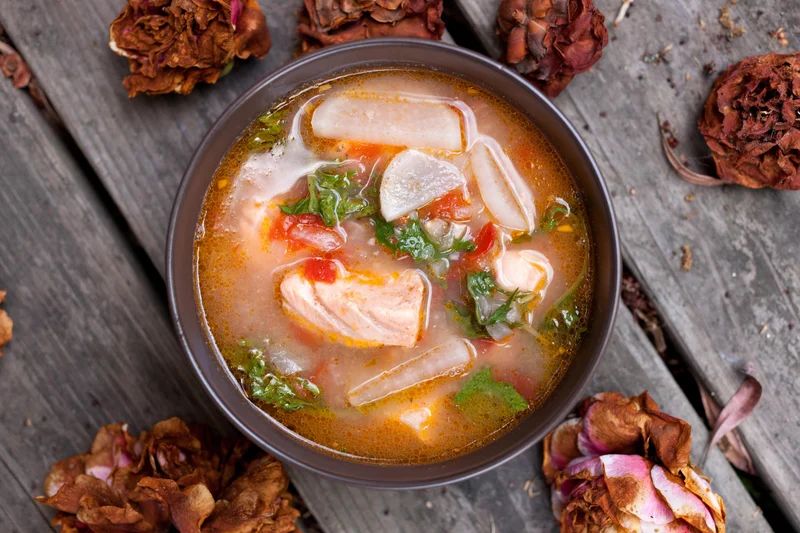Few cuisines value sourness quite as much as Filipino. Whether from vinegar, citrus, or unripe fruits, sourness adds sparkle, helping balance intensely fishy flavors and rich, fatty meats. The Philippines’ quintessential sour dish is sinigang, a seafood soup that usually relies on tamarind pulp for tartness, but calamansi or lime juice is used here instead. This recipe is from Marvin Gapultos, who writes the Burnt Lumpia blog, and what’s unusual in this version is the salmon and miso—the latter probably dates to World War II, during Japan’s occupation of the Philippines, but salmon? Gapultos thinks it could be the legacy of Filipino workers in Alaska’s canneries in the early 20th century.
What to buy: The calamansi is a smaller, slightly milder cousin of the lime—if you can’t find it in your local Asian market, fresh lime juice makes an acceptable substitute.
Miso is a Japanese culinary staple made by fermenting rice, barley, or, most commonly, soy. The two main types are white (or shiro) miso, which has a sweet, mild flavor, and red (or aka) miso, which is aged and has a salty, umami flavor. You can find miso paste refrigerated at most grocery stores.
Game plan: You’ll need to make the steamed rice before you begin.
Click here to see more 21st-century Filipino recipes.
- Yield: 4 to 6 servings
- Difficulty: Easy
- Total: 1 hr
- Active: 40 mins
Ingredients (15)
- 1 tablespoon vegetable oil
- 1 small red onion, medium dice
- 3 medium garlic cloves, minced
- 1 teaspoon kosher salt, plus more as needed
- 2 medium Roma tomatoes, cored and medium dice
- 1 cup dry white wine
- 4 cups water
- 8 ounces daikon radish, peeled, halved lengthwise, and cut crosswise into 1/4-inch-thick slices
- 3 tablespoons freshly squeezed calamansi or lime juice (from about 2 medium limes or 2 large calamansi), plus more as needed
- 2 tablespoons fish sauce
- 2 tablespoons white miso
- 1 pound salmon, skin and pin bones removed and cut into 1-inch cubes
- 1 cup packed, coarsely chopped Asian mustard greens, such as mizuna
- Freshly ground black pepper
- Steamed white rice, for serving
Instructions
- Heat the oil in a large saucepan over medium heat until shimmering. Add the onion, garlic, and measured salt and cook, stirring occasionally, until softened, about 5 to 8 minutes. Add the tomatoes and cook, stirring occasionally, until softened, about 3 to 5 minutes.
- Increase the heat to medium high, add the wine, scrape up any browned bits from the bottom of the pot, and bring to a boil. Reduce the heat to medium low and simmer until the wine is reduced by about half, about 7 minutes.
- Add the water, daikon, measured calamansi or lime juice, and fish sauce, stir to combine, and return to a simmer. Reduce the heat to low, cover with a tightfitting lid, and simmer until the daikon starts to soften, about 10 minutes.
- Ladle about 1/2 cup of the liquid into a small bowl, add the miso, and stir until completely dissolved. Add the miso mixture back to the pot and stir to combine.
- Increase the heat to medium, add the salmon and greens, and stir to combine. Simmer until the salmon is just cooked through and the greens have softened, about 3 minutes. Taste and season with additional salt and calamansi or lime juice as needed. Ladle into bowls, season with pepper, and serve with steamed rice.

